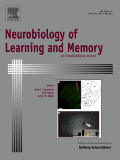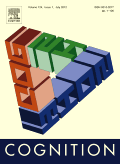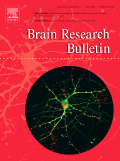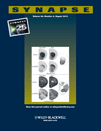
NEUROBIOLOGY OF LEARNING AND MEMORY
Scope & Guideline
Unlocking the Secrets of Learning and Memory
Introduction
Aims and Scopes
- Neurobiological Mechanisms of Learning and Memory:
The journal extensively explores the cellular and molecular underpinnings of learning and memory, including the roles of neurotransmitters, hormones, and neural circuits. - Behavioral and Cognitive Approaches:
Research often employs behavioral paradigms to assess memory functions, examining how different factors such as stress, exercise, and pharmacological interventions influence learning and memory. - Developmental and Comparative Studies:
The journal includes studies on various species, highlighting developmental aspects of memory and how learning processes differ across ages and species. - Clinical Implications and Neuropsychology:
Articles often discuss the implications of learning and memory research in clinical settings, particularly regarding neurodegenerative diseases, psychiatric disorders, and rehabilitation. - Innovative Methodologies:
The journal showcases cutting-edge methodologies, including optogenetics, pharmacological manipulations, and advanced imaging techniques to study memory processes.
Trending and Emerging
- Neuroplasticity and Memory Consolidation:
There is a growing emphasis on understanding how neuroplastic changes contribute to memory consolidation, particularly in relation to sleep, stress, and various interventions. - Interdisciplinary Approaches to Memory Research:
Recent studies frequently integrate findings from psychology, neuroscience, genetics, and pharmacology, showcasing an interdisciplinary approach to understanding learning and memory. - Impact of Physical Activity and Lifestyle on Cognition:
Research exploring the benefits of exercise and lifestyle factors on cognitive function and memory has gained traction, emphasizing the importance of environmental influences on neurobiology. - Sex Differences in Learning and Memory:
An increasing number of studies are focusing on how sex differences affect learning and memory processes, revealing significant insights into the neurobiological mechanisms driving these differences. - Translational Research and Clinical Applications:
There is a notable trend towards translating basic research findings into clinical applications, particularly concerning neurodegenerative disorders and therapeutic interventions.
Declining or Waning
- Focus on Traditional Learning Models:
There has been a noticeable decline in studies centered around classical conditioning and traditional learning models, as research has increasingly shifted towards more complex and integrative approaches. - Less Emphasis on Simple Behavioral Paradigms:
Earlier publications often relied heavily on simpler behavioral assessments; however, recent trends indicate a move towards more sophisticated and multidimensional paradigms that assess cognitive processes. - Reduction in Studies on Aversive Learning:
Research investigating aversive conditioning and fear learning has decreased, possibly due to a growing interest in positive reinforcement and the exploration of cognitive flexibility.
Similar Journals

Cognition
Fostering Interdisciplinary Collaboration in CognitionCognition, published by Elsevier, is a leading journal dedicated to the exploration and advancement of knowledge in the multifaceted fields of cognitive neuroscience, cognitive psychology, and linguistics. Since its inception in 1972, this prestigious journal has established itself as a prominent platform for disseminating innovative research and critical reviews, achieving a remarkable Q1 ranking across various relevant categories, including Cognitive Neuroscience and Developmental Psychology, as per the 2023 metrics. With a focus on providing insights that are vital for researchers, professionals, and students alike, Cognition boasts an impressive standing in the academic community, evidenced by its high Scopus rankings which place it in the top percentiles in several disciplines. Researchers interested in the cognitive processes underlying human thought, language, and behavior will find Cognition an invaluable resource that publishes cutting-edge findings and fosters interdisciplinary collaboration. Though it operates under a traditional access model, the breadth and depth of its content ensure it remains integral to advancing cognitive science.

BRAIN RESEARCH BULLETIN
Advancing the frontiers of neuroscience research.BRAIN RESEARCH BULLETIN is a leading academic journal published by PERGAMON-ELSEVIER SCIENCE LTD, dedicated to the dissemination of high-quality research in the interdisciplinary field of neuroscience. Since its inception in 1976, this journal has served as a vital platform for researchers, professionals, and students interested in a broad spectrum of topics within neuroscience, making significant contributions to the understanding of brain function and its associated disorders. With a commendable impact factor and a current Scopus rank of #35 out of 113 in general neuroscience, the journal holds a Q2 quartile ranking, underscoring its relevance and influence in the academic community. BRAIN RESEARCH BULLETIN invites submissions of original articles, reviews, and brief communications, enhancing scholarly communication within this dynamic field. Although the journal is not open access, it ensures widespread reach and impact through various subscription models, allowing access to pivotal findings that pave the way for future research advancements. For researchers aiming to share impactful discoveries and insights within the neuroscience community, BRAIN RESEARCH BULLETIN remains an essential outlet.

eNeuro
Fostering connections in the ever-evolving field of neuroscience.eNeuro is a prominent open-access journal published by the Society for Neuroscience, dedicated to advancing the field of neuroscience through the dissemination of high-quality research. Launched in 2015, it reflects its commitment to accessibility by providing a platform for innovative studies and advancements in neurobiology. The journal holds a strong reputation, achieving a Q1 ranking in Medicine (miscellaneous) and a Q2 in Neuroscience (miscellaneous) as of 2023, with Scopus rankings placing it at #56 out of 113 in General Neuroscience, marking it in the 50th percentile. With its convergence to cover articles from 2014 to 2024, eNeuro continues to serve as a vital resource for researchers, professionals, and students alike, offering a comprehensive hub for the latest discoveries and theoretical developments in neuroscience. As part of its mission, eNeuro aims to foster collaboration and inspire the academic community with openly accessible content, making significant contributions to scientific discourse.

Behavioral and Brain Functions
Unraveling the Connections Between Brain and BehaviorBehavioral and Brain Functions is a leading Open Access journal published by BMC, dedicated to advancing the field of behavioral neuroscience, cognitive neuroscience, and biological psychiatry since its inception in 2005. This esteemed journal, based in the United Kingdom, has established itself as a vital resource for researchers and professionals, boasting a remarkable influence demonstrated by its Q1 and Q2 rankings across multiple relevant categories. With its commitment to providing unrestricted access to high-quality research, the journal facilitates the dissemination of significant findings in understanding the complex interactions between behavior and brain function. The journal ranks impressively within the Scopus database, positioning itself among the top-tier publications in its categories, making it an essential platform for academic discourse and innovation. As it converges through 2024, Behavioral and Brain Functions continues to play a crucial role in shaping the forefront of neuroscientific inquiry, inviting contributions that challenge our understanding and promote further exploration in these dynamic fields.

LEARNING & MEMORY
Exploring the Frontiers of NeuroscienceLEARNING & MEMORY is a prestigious journal dedicated to the expansive field of neuroscience, focusing specifically on the intricate mechanisms underlying learning processes and memory formation. Published by COLD SPRING HARBOR LAB PRESS, PUBLICATIONS DEPT, this journal has established itself as a critical platform for research since its inception in 1994, with an anticipated convergence until 2024. With a notable impact factor in the realms of cellular and molecular neuroscience, cognitive neuroscience, and neuropsychology, it proudly ranks in the top quartiles of these disciplines. Although the journal is not open access, it remains a vital resource for scholars seeking to leverage cutting-edge research to advance their understanding of cognitive processes. Those engaged in the fields of psychology and neuroscience will find LEARNING & MEMORY to be an essential source for empirical studies, theoretical reviews, and methodological advancements, making it indispensable for researchers, professionals, and aspiring students alike.

JOURNAL OF COGNITIVE NEUROSCIENCE
Bridging neuroscience and cognition with groundbreaking research.Welcome to the JOURNAL OF COGNITIVE NEUROSCIENCE, a premier publication in the field of cognitive neuroscience, published by the esteemed MIT PRESS. Since its inception in 1989, this journal has been at the forefront of advancing our understanding of the neural mechanisms underlying cognitive processes, boasting an impressive convergence period through 2024. With its Q1 ranking in the 2023 cognitive neuroscience category, it stands out among 115 peers, indicating its critical role in shaping contemporary research. The journal offers a comprehensive array of research articles, reviews, and methodologies aimed at researchers, professionals, and students alike, facilitating the exploration of complex cognitive functions. While not an open-access journal, it provides essential insights and significant contributions to the neuroscience community, making it an invaluable resource for anyone keen on delving into the intricacies of the human brain.

BEHAVIOURAL BRAIN RESEARCH
Advancing Insights into Brain-Behavior DynamicsBEHAVIOURAL BRAIN RESEARCH, published by Elsevier, is a leading scholarly journal that has been at the forefront of research in Behavioral Neuroscience since its inception in 1980. With an ISSN of 0166-4328 and an e-ISSN of 1872-7549, this journal caters to a global audience of researchers and professionals keen on exploring the intricate relationships between behavior and neural processes. As of 2023, it holds an impressive Q2 ranking within its category, showcasing its significant impact with a Scopus rank of #28 out of 88 in the field, placing it in the 68th percentile. While the journal does not offer open access, it remains accessible through institutional subscriptions, ensuring that its high-quality research is disseminated effectively. The journal's commitment to advancing knowledge in behavioral neuroscience makes it an indispensable resource for those looking to delve deep into the complexities of brain-behavior interactions and foster innovative approaches in both research and clinical applications.

SYNAPSE
Illuminating Synaptic Mechanisms, Inspiring DiscoverySYNAPSE, an esteemed journal in the field of Cellular and Molecular Neuroscience, is published by Wiley and serves as a vital platform for disseminating groundbreaking research in neuroscience. Established in 1987, this journal has been pivotal in exploring the intricate mechanisms governing synaptic function and neural communication, contributing to our understanding of the nervous system. With an ISSN of 0887-4476 and an E-ISSN of 1098-2396, SYNAPSE is indexed in Scopus and currently holds a Q4 quartile ranking in its category, reflecting its niche yet significant presence within the research community. Despite its recent ranking in the 21st percentile among its peers, the journal’s commitment to quality and innovation remains unwavering. It is published from Hoboken, New Jersey, and although it is not an open-access journal, it provides invaluable insights and critical reviews that are pivotal for researchers, professionals, and students alike who seek to advance their knowledge in the dynamic field of neuroscience. Join us in contributing to the ever-evolving discourse in cellular and molecular neuroscience through SYNAPSE.

Journal of Neuropsychology
Exploring the Neural Basis of Behavior and CognitionThe Journal of Neuropsychology, published by WILEY, is a premier academic journal dedicated to advancing the field of neuropsychology and its related disciplines. With a focus on behavioral and cognitive neuroscience, this journal presents cutting-edge research that informs our understanding of psychological functions and their underlying neural mechanisms. Operating with an impressive impact factor representative of its rigorous peer-review process, the journal has established itself within the Q2 and Q3 quartiles of multiple relevant categories, including Neuropsychology and Physiological Psychology. Researchers will find the ISSN 1748-6645 and E-ISSN 1748-6653 useful for academic referencing as they explore articles that span innovative methodologies and insights into neurological conditions. Published continuously since 2007, the Journal of Neuropsychology stands as a vital resource for professionals and students alike, fostering scholarly discourse and knowledge exchange in neuropsychological research.

Brain Communications
Fostering Knowledge in Neuroscience and PsychiatryBrain Communications is an esteemed, open-access academic journal published by Oxford University Press since 2019, focusing on the dynamic field of neuroscience. With a dedicated ISSN and an E-ISSN of 2632-1297, this journal aims to address the intricate relationships between brain functions, psychiatric disorders, and neurobiological mechanisms. The journal stands out in the academic realm, holding a prestigious Q1 ranking across several categories, including Biological Psychiatry, Cellular and Molecular Neuroscience, Neurology, and Psychiatry and Mental Health for 2023. Notably, it has also secured impressive Scopus ranks in various neuroscience and psychiatry fields, evidencing its commitment to high-quality research. With an impact factor reflective of its growing influence, Brain Communications provides accessible research findings to professionals, researchers, and students alike, fostering a deeper understanding of complex neurological phenomena. This innovative journal is pivotal for anyone involved in advancing knowledge in neuroscience and mental health.